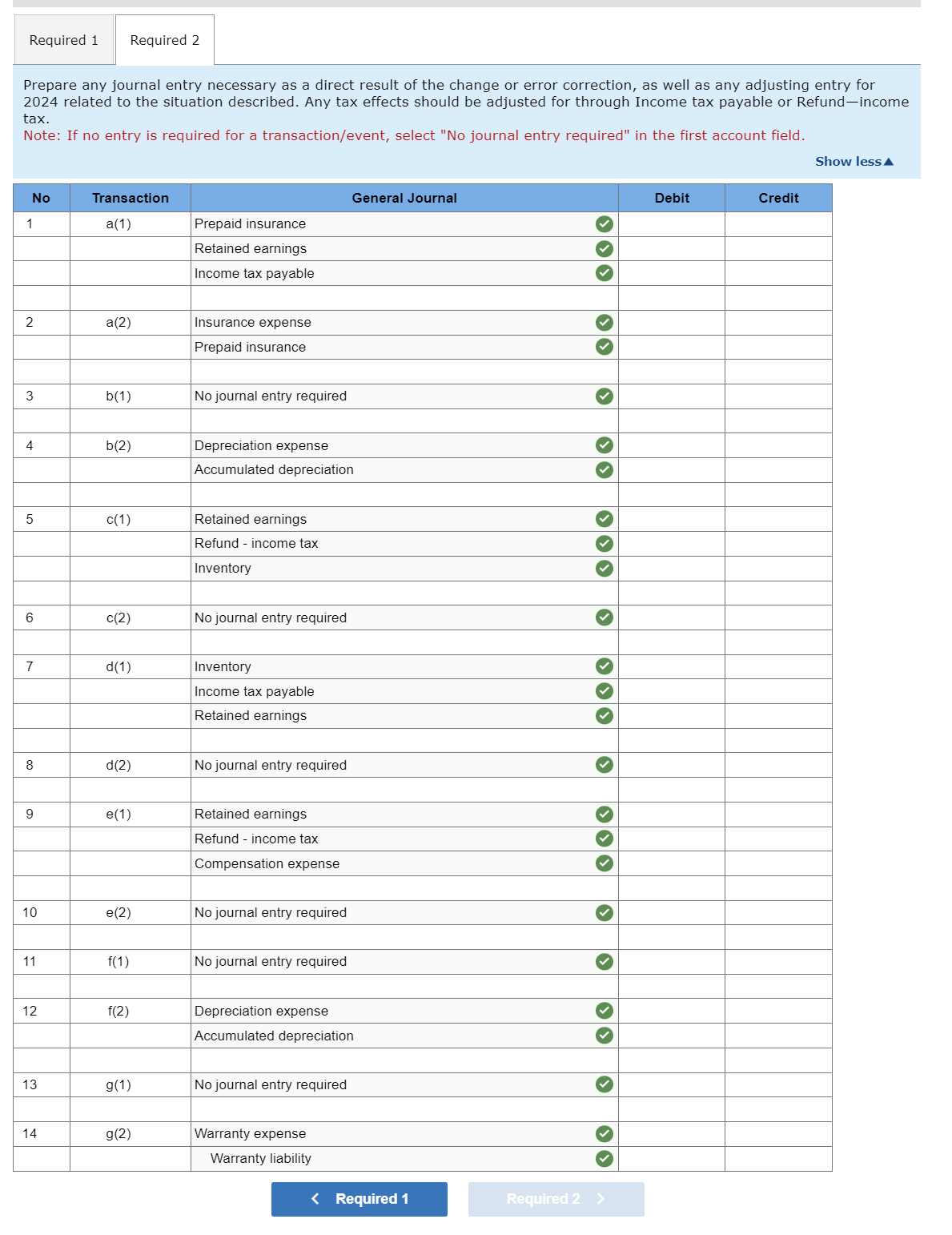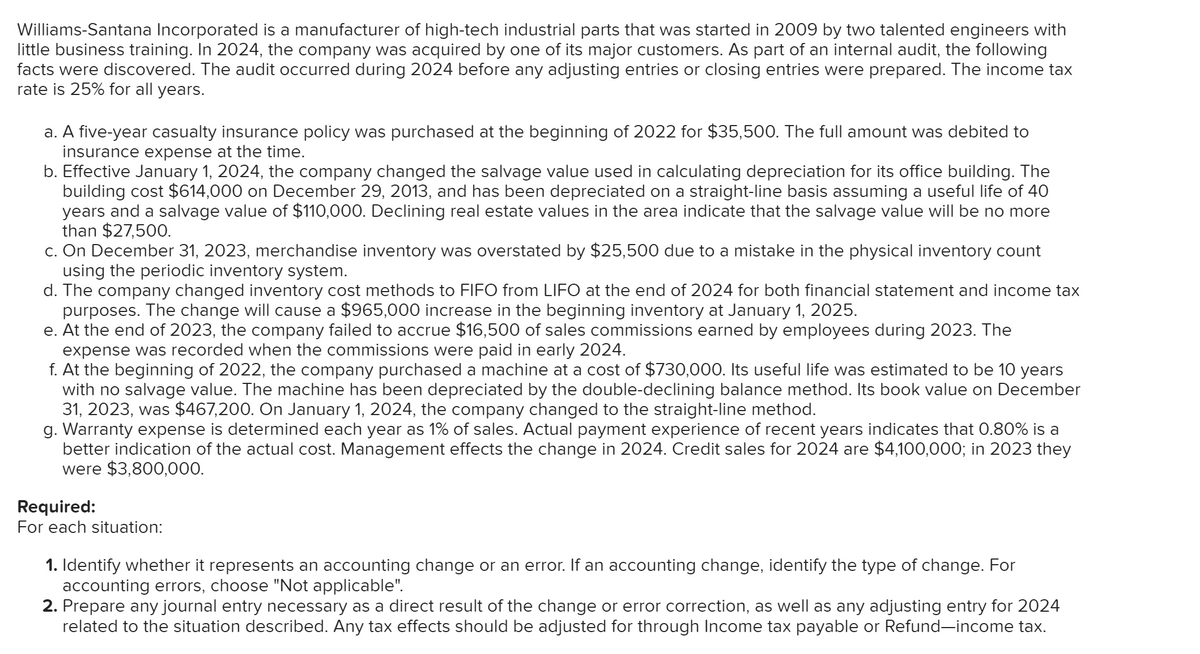Williams-Santana Incorporated is a manufacturer of high-tech industrial parts that was started in 2009 by two talented engineers with little business training. In 2024, the company was acquired by one of its major customers. As part of an internal audit, the following facts were discovered. The audit occurred during 2024 before any adjusting entries or closing entries were prepared. The income tax rate is 25% for all years. a. A five-year casualty insurance policy was purchased at the beginning of 2022 for $35,500. The full amount was debited to insurance expense at the time. b. Effective January 1, 2024, the company changed the salvage value used in calculating depreciation for its office building. The building cost $614,000 on December 29, 2013, and has been depreciated on a straight-line basis assuming a useful life of 40 years and a salvage value of $110,000. Declining real estate values in the area indicate that the salvage value will be no more than $27,500. c. On December 31, 2023, merchandise inventory was overstated by $25,500 due to a mistake in the physical inventory count using the periodic inventory system. d. The company changed inventory cost methods to FIFO from LIFO at the end of 2024 for both financial statement and income tax purposes. The change will cause a $965,000 increase in the beginning inventory at January 1, 2025. e. At the end of 2023, the company failed to accrue $16,500 of sales commissions earned by employees during 2023. The expense was recorded when the commissions were paid in early 2024. f. At the beginning of 2022, the company purchased a machine at a cost of $730,000. Its useful life was estimated to be 10 years with no salvage value. The machine has been depreciated by the double-declining balance method. Its book value on December 31, 2023, was $467,200. On January 1, 2024, the company changed to the straight-line method. g. Warranty expense is determined each year as 1% of sales. Actual payment experience of recent years indicates that 0.80% is a better indication of the actual cost. Management effects the change in 2024. Credit sales for 2024 are $4,100,000; in 2023 they were $3,800,000. Required: For each situation: 1. Identify whether it represents an accounting change or an error. If an accounting change, identify the type of change. For accounting errors, choose "Not applicable". 2. Prepare any journal entry necessary as a direct result of the change or error correction, as well as any adjusting entry for 2024 related to the situation described. Any tax effects should be adjusted for through Income tax payable or Refund-income tax.
Williams-Santana Incorporated is a manufacturer of high-tech industrial parts that was started in 2009 by two talented engineers with little business training. In 2024, the company was acquired by one of its major customers. As part of an internal audit, the following facts were discovered. The audit occurred during 2024 before any adjusting entries or closing entries were prepared. The income tax rate is 25% for all years. a. A five-year casualty insurance policy was purchased at the beginning of 2022 for $35,500. The full amount was debited to insurance expense at the time. b. Effective January 1, 2024, the company changed the salvage value used in calculating depreciation for its office building. The building cost $614,000 on December 29, 2013, and has been depreciated on a straight-line basis assuming a useful life of 40 years and a salvage value of $110,000. Declining real estate values in the area indicate that the salvage value will be no more than $27,500. c. On December 31, 2023, merchandise inventory was overstated by $25,500 due to a mistake in the physical inventory count using the periodic inventory system. d. The company changed inventory cost methods to FIFO from LIFO at the end of 2024 for both financial statement and income tax purposes. The change will cause a $965,000 increase in the beginning inventory at January 1, 2025. e. At the end of 2023, the company failed to accrue $16,500 of sales commissions earned by employees during 2023. The expense was recorded when the commissions were paid in early 2024. f. At the beginning of 2022, the company purchased a machine at a cost of $730,000. Its useful life was estimated to be 10 years with no salvage value. The machine has been depreciated by the double-declining balance method. Its book value on December 31, 2023, was $467,200. On January 1, 2024, the company changed to the straight-line method. g. Warranty expense is determined each year as 1% of sales. Actual payment experience of recent years indicates that 0.80% is a better indication of the actual cost. Management effects the change in 2024. Credit sales for 2024 are $4,100,000; in 2023 they were $3,800,000. Required: For each situation: 1. Identify whether it represents an accounting change or an error. If an accounting change, identify the type of change. For accounting errors, choose "Not applicable". 2. Prepare any journal entry necessary as a direct result of the change or error correction, as well as any adjusting entry for 2024 related to the situation described. Any tax effects should be adjusted for through Income tax payable or Refund-income tax.
Chapter16: Accounting Periods And Methods
Section: Chapter Questions
Problem 3DQ
Related questions
Question
78.
Subject:- Accounting

Transcribed Image Text:Required 1 Required 2
Prepare any journal entry necessary as a direct result of the change or error correction, as well as any adjusting entry for
2024 related to the situation described. Any tax effects should be adjusted for through Income tax payable or Refund-income
tax.
Note: If no entry is required for a transaction/event, select "No journal entry required" in the first account field.
No
1
2
3
4
5
6
7
8
9
10
11
12
13
14
Transaction
a(1)
a(2)
b(1)
b(2)
c(1)
c(2)
d(1)
d(2)
e(1)
e(2)
f(1)
f(2)
g(1)
g(2)
Prepaid insurance
Retained earnings
Income tax payable
Insurance expense
Prepaid insurance
No journal entry required
Depreciation expense
Accumulated depreciation
Retained earnings
Refund - income tax
Inventory
No journal entry required
Inventory
Income tax payable
Retained earnings
No journal entry required
Retained earnings
Refund - income tax
Compensation expense
No journal entry required
No journal entry required
General Journal
Depreciation expense
Accumulated depreciation
No journal entry required
Warranty expense
Warranty liability
< Required 1
3
Required 2 >
Debit
Credit
Show less

Transcribed Image Text:Williams-Santana Incorporated is a manufacturer of high-tech industrial parts that was started in 2009 by two talented engineers with
little business training. In 2024, the company was acquired by one of its major customers. As part of an internal audit, the following
facts were discovered. The audit occurred during 2024 before any adjusting entries or closing entries were prepared. The income tax
rate is 25% for all years.
a. A five-year casualty insurance policy was purchased at the beginning of 2022 for $35,500. The full amount was debited to
insurance expense at the time.
b. Effective January 1, 2024, the company changed the salvage value used in calculating depreciation for its office building. The
building cost $614,000 on December 29, 2013, and has been depreciated on a straight-line basis assuming a useful life of 40
years and a salvage value of $110,000. Declining real estate values in the area indicate that the salvage value will be no more
than $27,500.
c. On December 31, 2023, merchandise inventory was overstated by $25,500 due to a mistake in the physical inventory count
using the periodic inventory system.
d. The company changed inventory cost methods to FIFO from LIFO at the end of 2024 for both financial statement and income tax
purposes. The change will cause a $965,000 increase in the beginning inventory at January 1, 2025.
e. At the end of 2023, the company failed to accrue $16,500 of sales commissions earned by employees during 2023. The
expense was recorded when the commissions were paid in early 2024.
f. At the beginning of 2022, the company purchased a machine at a cost of $730,000. Its useful life was estimated to be 10 years
with no salvage value. The machine has been depreciated by the double-declining balance method. Its book value on December
31, 2023, was $467,200. On January 1, 2024, the company changed to the straight-line method.
g. Warranty expense is determined each year as 1% of sales. Actual payment experience of recent years indicates that 0.80% is a
better indication of the actual cost. Management effects the change in 2024. Credit sales for 2024 are $4,100,000; in 2023 they
were $3,800,000.
Required:
For each situation:
1. Identify whether it represents an accounting change or an error. If an accounting change, identify the type of change. For
accounting errors, choose "Not applicable".
2. Prepare any journal entry necessary as a direct result of the change or error correction, as well as any adjusting entry for 2024
related to the situation described. Any tax effects should be adjusted for through Income tax payable or Refund-income tax.
Expert Solution
This question has been solved!
Explore an expertly crafted, step-by-step solution for a thorough understanding of key concepts.
This is a popular solution!
Trending now
This is a popular solution!
Step by step
Solved in 4 steps with 5 images

Knowledge Booster
Learn more about
Need a deep-dive on the concept behind this application? Look no further. Learn more about this topic, accounting and related others by exploring similar questions and additional content below.Recommended textbooks for you


Individual Income Taxes
Accounting
ISBN:
9780357109731
Author:
Hoffman
Publisher:
CENGAGE LEARNING - CONSIGNMENT



Individual Income Taxes
Accounting
ISBN:
9780357109731
Author:
Hoffman
Publisher:
CENGAGE LEARNING - CONSIGNMENT



Intermediate Accounting: Reporting And Analysis
Accounting
ISBN:
9781337788281
Author:
James M. Wahlen, Jefferson P. Jones, Donald Pagach
Publisher:
Cengage Learning
